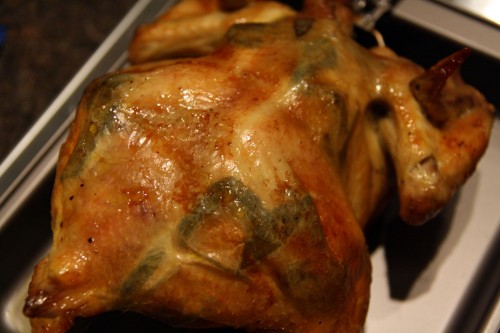I love posting recipes here on NOH. Not only because I get to share some delicious recipe for you to recreate at home, but because it usually means that Charlie S. (a regular commenter here) is going to share something amazingly insightful about his personal cooking knowledge, which is seemingly vast and wonderfully delicious. I cannot tell you how much I enjoy reading his comments and learning from him.
The last time I made a rotisserie chicken in our oven (which is so magical and has it’s own spit — which I actually got to turn on its own this time!), Charlie shared the following details about a chicken recipe that just sounded incredible. So last week when I managed to find the new chicken market here in town, I had to try this out.
We got the most beautiful bird from them, slaughtered the day before I bought it and you can definitely tell. It’s totally homegrown, no antibiotics, no steroids, and so full of flavor. Not to mention that the chicken nearly melts in your mouth!
In the past year, I have really come to appreciate the beautiful combination that is chicken and sage. We have a very hearty sage plant that grows outside one of our windows in a window box, and no amount of winter winds or snow seems to phase it. My only challenge has been keeping up with its growth so none of the delicious leaves go to waste.
I have to say that this chicken was absolutely delicious and wonderfully tender. I think it just became a favorite in our house, and we made some killer sandwiches with the leftover breast meat, homemade hamburger buns and mozzarella slices. And of course I used up the bones, skin and tiny bits of meat left over to make an amazing pot of chicken soup.
So let’s get on with the cooking. Here is the comment that Charlie left for me:
I like to brine the bird for a few hours, place a few garlic cloves and a rough chopped lemon in the body cavity, very carefully loosen the skin from the body without tearing the skin, then place fresh sage leaves and liberal amounts of black pepper under the skin.
I am from the school of thought that says there is no such thing as too much garlic. I have stuffed the body cavity “full” of unpeeled garlic and then plugged the opening with a stick of celery to prevent the garlic from falling out during the chicken’s time on the rotisserie.
The garlic peels easily after cooking and has a sweet nutty flavor that is good spread on a crusty piece of bread. It’s not strong tasting at all but if you want you can dilute it by mixing with a little Greek yogurt or regular yogurt that has been drained of whey. Makes a very healthy mayonnaise replacement.
Once the bird is trussed and skewered I can put it on the rotisserie and forget about it for about an hour and thirty minutes. When the temperature at the thickest part of the breast is 180 the bird can be removed from the oven and allowed to rest for about thirty minutes.
While the bird is resting I skim most of the fat from the pan it was cooked over then deglaze with a bit of red wine and use this sauce on the mashed parsnips I prefer to serve rather that potatoes.
Now if you’re not the kind of person that can just fly by the seat of your pants in the kitchen, don’t worry. I’ve written out an actual recipe.

| Servings |
|
- 1 gallon water
- 3 tablespoons Sea salt
- A handful of fresh sage leaves coarsely chopped
- 1 tablespoon garlic pepper
- 1 whole chicken about 4 pounds
- 1 cloves head of garlic separated but not peeled
- A handful of pepper corns
- A healthy handful of fresh sage leaves
- 1 tablespoons lemon or 2lemon juice
- 1 stalk celery
- 1 cup white or red wine for roasting
- 1 cup white or red wine for the sauce
- Salt & pepper to taste
Ingredients
|

|
- Place the chicken into a large plastic ziploc bag or bowl. Combine ingredients and pour over the chicken. Marinate the chicken for 2 hours or more.
- Drain the marinade off and let the chicken dry. Carefully peel up a bit of the skin of the chicken and begin to stuff the sage leaves all over. You can also shove pepper in there but I found it to be rather messy.
- Stuff chicken cavity with garlic cloves, pepper corns, sage leaves and lemon. Cut celery into pieces long enough to fit across the cavity of the chicken so everything will stay inside.
- Place broiler pan in bottom of oven and rotisserie rack in the appropriate rack space (second from the bottom in ours).
- Place chicken on rotisserie stake and put into oven. Pour 1 cup white wine into the roasting pan. Roast chicken for 1.5 to 2 hours at 400°F (200°C). Take an internal temperature in the thigh and breast. When it reaches 180°F (83°C) it is done. The juices from the chicken should also run clear.
- Remove chicken from oven and let stand for 15-30 minutes before serving.
- While the chicken rests, collect drippings from the roasting pan and pour into a small skillet. Add red or white wine (whatever you steamed the chicken with) and reduce it down to about half, or whatever thickness you desire. You can also mix 1 tablespoon each of water and cornstarch and mix this into the sauce, stirring constantly, so that it thickens. Add salt and pepper to taste.
Serve with mashed potatoes (or parsnips) and a favorite vegetable like sugared carrots or green beans.





